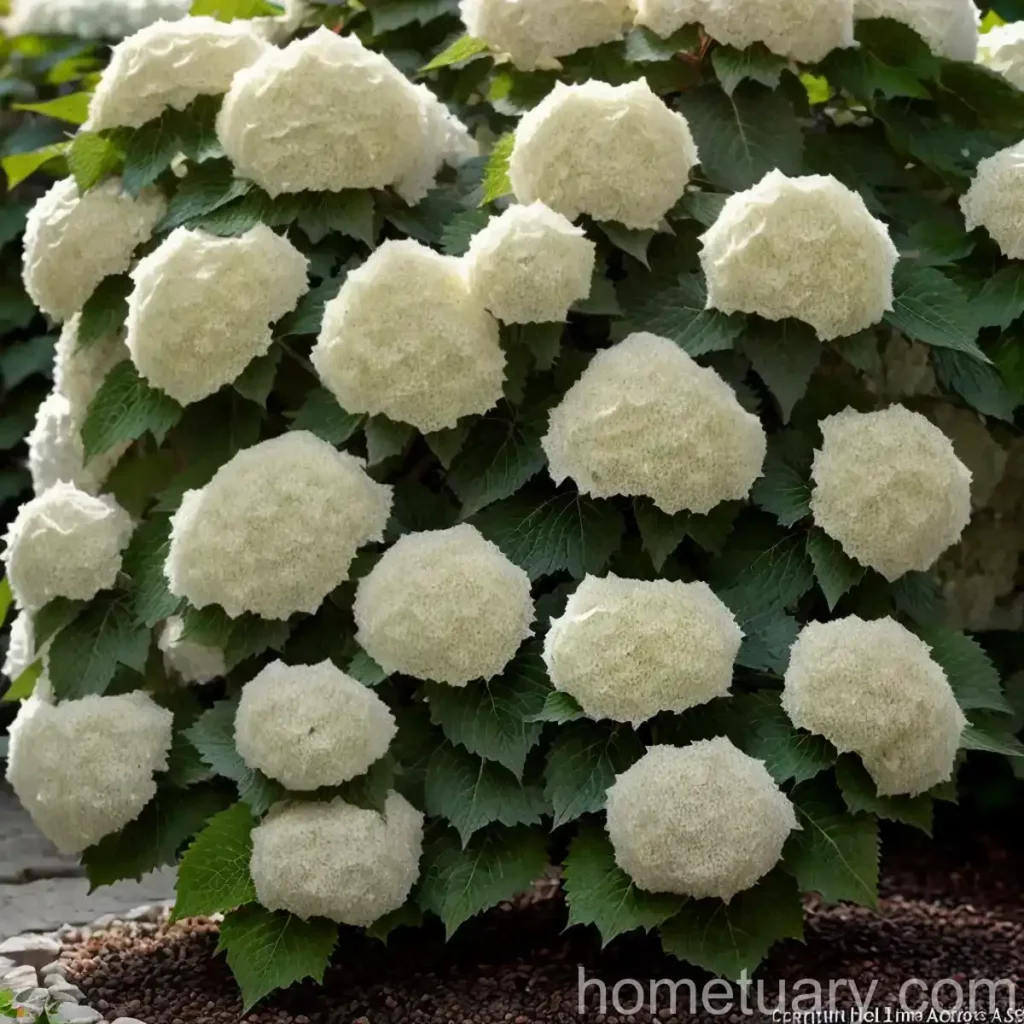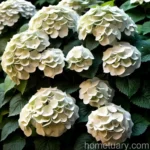The Oakleaf Hydrangea (Hydrangea quercifolia ‘Little Honey’)
Hydrangeas are a much-loved group of ornamental plants for their large, showy flower heads and attractive foliage. One particularly delightful member of this group is the Oakleaf Hydrangea, scientifically known as Hydrangea quercifolia ‘Little Honey’. This beautiful shrub is prized for its stunning foliage, elegant blooms, and its adaptability to various garden settings. In this comprehensive guide, we will delve into the in-depth care and cultivation of the Oakleaf Hydrangea, exploring everything from its cultural requirements and landscape uses to propagation and common diseases. So, if you’re intrigued by this captivating plant, read on to discover the secrets of nurturing the charming Oakleaf Hydrangea.
What is the Oakleaf Hydrangea?
The Oakleaf Hydrangea, native to the southeastern United States, is a deciduous shrub that is part of the Hydrangeaceae family. This species is a cultivar of the species Hydrangea quercifolia, known for its unique oak-like foliage and cone-shaped, creamy white flowers. The ‘Little Honey’ variety is particularly prized for its vibrant, golden-yellow new foliage that gradually matures to a soft green as the season progresses.
Featuring large, distinctively lobed leaves and exquisitely textured bark, Oakleaf Hydrangeas offer year-round visual interest in the garden. The plant typically grows to a height of 3-5 feet, with a similar spread, and thrives in USDA Hardiness Zones 5 to 9. In addition to its stunning foliage, the Oakleaf Hydrangea blooms in early summer, producing elongated flower panicles that gradually turn pink as they age, extending the visual appeal into the fall.
The Oakleaf Hydrangea’s striking appearance and its adaptability to a wide range of growing conditions make it a popular choice among gardeners seeking a versatile and visually appealing landscape shrub.
Key Takeaways – Oakleaf Hydrangea (Hydrangea quercifolia ‘Little Honey’)
Before diving into the details of caring for the Oakleaf Hydrangea, let’s take a quick look at the key takeaways to be explored in this comprehensive guide:
- Culture – Understanding the cultural requirements of Oakleaf Hydrangeas for optimal growth and development.
- Uses – Exploring the diverse landscaping uses of this versatile shrub, from its role in privacy screens to attracting pollinators.
- Water – Learning about the watering needs of the Oakleaf Hydrangea and best practices for maintaining soil moisture.
- Sunlight – Discovering the ideal sunlight conditions for cultivating healthy and vibrant Oakleaf Hydrangeas.
- Fertilizer – Exploring the role of fertilization in promoting robust growth and flower production in Oakleaf Hydrangeas.
- Soil – Understanding the soil requirements and best soil practices for planting and maintaining Oakleaf Hydrangeas.
- Pruning – Discussing the essential pruning techniques to maintain the health and shape of Oakleaf Hydrangeas.
- Propagation – Exploring various methods of propagating Oakleaf Hydrangeas to expand your garden collection.
- Container Popularity – Understanding the suitability of Oakleaf Hydrangeas for growing in containers and their maintenance requirements.
- Common Diseases – Identifying common diseases that may affect Oakleaf Hydrangeas and measures to prevent and address them.
- Disease Diagnosis – Understanding the symptoms and diagnostic methods for diseases that can afflict Oakleaf Hydrangeas.
- Common Pests – Recognizing the prevalent pests that can target Oakleaf Hydrangeas and strategies for pest management.
- Botanist’s Tips – Offering insights and expert tips from botanists for successfully cultivating Oakleaf Hydrangeas.
- Fun Facts – Uncovering interesting and lesser-known facts about the Oakleaf Hydrangea and its ecological significance.
Now that we have a glimpse of what lies ahead, let’s explore each of these facets in detail, providing a holistic understanding of the Oakleaf Hydrangea’s care and cultivation.
Culture
Cultural practices play a crucial role in ensuring the optimal growth and performance of the Oakleaf Hydrangea. Understanding its cultural requirements will enable us to create an environment that supports the plant’s vitality and visual appeal.
Water
Oakleaf Hydrangeas have moderate water needs and are relatively drought-tolerant once established. However, consistent moisture is essential, especially during the plant’s early establishment and flowering periods. Here are some key considerations for watering Oakleaf Hydrangeas:
- Young Plants – Newly planted Oakleaf Hydrangeas should be watered regularly to keep the root ball evenly moist. This is particularly important during hot and dry spells.
- Established Plants – Once established, Oakleaf Hydrangeas typically require water during extended dry periods. A general guideline is to provide around 1 inch of water per week, either through rainfall or manual watering.
- Soil Moisture – Ensuring well-draining soil is crucial to prevent waterlogging, which can lead to root rot. Mulching around the base of the plant can help retain soil moisture and regulate the soil temperature.
Sunlight
Proper sunlight exposure is vital for the growth and flowering of Oakleaf Hydrangeas. Understanding the sunlight requirements will help in selecting the ideal planting location for these shrubs:
- Morning Sun, Afternoon Shade – Oakleaf Hydrangeas thrive in locations with partial to full sun, especially in the morning, while benefiting from partial shade during the hottest part of the day. This balance helps prevent leaf scorch and promotes healthy growth.
- Shade Tolerance – While they appreciate some direct sunlight, Oakleaf Hydrangeas are generally more tolerant of shade compared to other hydrangea species, making them suitable for woodland gardens and shaded borders.
Fertilizer
Appropriate fertilization supports the overall health and flowering performance of Oakleaf Hydrangeas. Utilizing the right fertilizers at the correct times enhances the plant’s vigor and flowering:
- Timing – Fertilize established Oakleaf Hydrangeas in early spring with a balanced, slow-release fertilizer to support healthy growth and flower production for the upcoming season.
- Avoid Overfertilization – Excessive use of fertilizer can lead to excessive vegetative growth at the expense of blooms in Oakleaf Hydrangeas. Follow the manufacturer’s recommendations for application rates or consult with a local nursery or horticulturist for specific guidance.
Soil
The soil composition and quality significantly influence the growth and development of Oakleaf Hydrangeas. Understanding the ideal soil conditions for these shrubs is essential for creating a suitable growing environment:
- Acidic Soil – Oakleaf Hydrangeas thrive in well-draining, acidic soil with a pH range of 5.2 to 6.5. Amending the soil with organic matter such as compost or peat moss can help maintain the desired acidity level and improve soil structure.
- Moisture Retention – While well-draining soil is critical, it should also retain sufficient moisture to support the plant’s water needs. Regularly checking the soil moisture and adjusting the watering frequency based on the soil’s moisture retention capacity is important for optimal growth.
Pruning
Pruning is an essential aspect of maintaining the health, shape, and flowering potential of Oakleaf Hydrangeas. Proper pruning techniques ensure the plant’s vitality and enhance its visual appeal:
- Timing – Prune Oakleaf Hydrangeas immediately after flowering, typically in late summer or early fall. This allows adequate time for the plant to set buds for the following year’s blooms.
- Deadheading – Removing spent flowers not only improves the plant’s appearance but also encourages continuous blooming in some varieties.
Propagation
Expanding your collection of Oakleaf Hydrangeas through propagation allows you to create new plants with desirable characteristics. Several methods can be used to propagate these shrubs:
- Softwood Cuttings – Softwood cuttings, taken in late spring to early summer, can be rooted to produce new plants. Ensuring high humidity and consistent moisture is crucial for successful rooting.
- Division – Dividing mature Oakleaf Hydrangeas in early spring can also yield new plants with minimal effort. Carefully separating the root ball into sections and replanting them can lead to successful propagation.
Container Popularity
While Oakleaf Hydrangeas are commonly grown in garden beds and borders, they can also thrive in containers if provided with the appropriate care and growing conditions:
- Container Selection – Choose large, sturdy containers with drainage holes to ensure adequate root space and prevent waterlogging.
- Soil and Watering – Utilize well-draining potting mix and monitor the soil moisture levels, ensuring the plant’s water needs are met without overwatering.
Now that we’ve delved into the cultural practices and care essentials for the Oakleaf Hydrangea, including water, sunlight, soil, fertilizer, pruning, and propagation, let’s turn our attention to common diseases and pests that may affect these beautiful shrubs.
Common Diseases and Pests
Despite being relatively low-maintenance plants, Oakleaf Hydrangeas can occasionally fall victim to diseases and pest infestations. Familiarizing yourself with the common issues and their management is crucial for preserving the health and beauty of your garden shrubs.
Common Diseases
Oakleaf Hydrangeas are generally resistant to many common hydrangea diseases, but they can still be affected by certain issues. Some prevalent diseases that may affect these shrubs include:
- Powdery Mildew – A fungal disease that manifests as a powdery white coating on the leaves, leading to leaf distortion and reduced plant vigor.
- Cercospora Leaf Spot – Characterized by the development of purple-reddish spots on the leaves, this fungal disease can cause premature leaf drop and affect the plant’s overall health.
- Anthracnose – Another fungal disease that can lead to brown, irregularly shaped lesions on the leaves, negatively impacting the plant’s vitality.
Disease Diagnosis
Diagnosing diseases in Oakleaf Hydrangeas involves observing the plant for specific symptoms and signs of infection. Here are some key diagnostic indicators for common diseases:
- Leaf Symptoms – Pay attention to any unusual spots, discoloration, or powdery coatings on the leaves, which can signal the presence of diseases.
- Stunted Growth – If the plant exhibits stunted growth, wilting, or abnormal leaf drop, investigate potential disease issues and take appropriate measures.
Common Pests
Oakleaf Hydrangeas are relatively resistant to pests, but certain insects can still pose threats to their health. Some common pests that may target these shrubs include:
- Aphids – Small, sap-sucking insects that can cluster on the undersides of leaves, leading to distorted growth and reduced vigor.
- Spider Mites – These tiny arachnids can cause stippling and webbing on the leaves, impacting the plant’s aesthetic appeal and overall health.
Botanist’s Tips
Receiving expert insights and tips from botanists and horticultural professionals can greatly enrich your understanding of Oakleaf Hydrangeas and contribute to successful cultivation. Here are some valuable tips from experts:
- Soil Testing – Conduct periodic soil tests to monitor the pH and nutrient levels, adjusting the soil composition as needed to maintain ideal growing conditions for Oakleaf Hydrangeas.
- Mulching Benefits – Utilize organic mulch around the base of the plant to conserve soil moisture, regulate soil temperature, and suppress weed growth, promoting the overall health of the shrub.
Fun Facts
Uncovering some intriguing and lesser-known facts about Oakleaf Hydrangeas can foster a deeper appreciation for these charming shrubs and highlight their ecological significance. Here are a few fun facts about Oakleaf Hydrangeas:
- Wildlife Habitats – The Oakleaf Hydrangea provides valuable habitat and forage for various pollinators, including bees and butterflies, contributing to the biodiversity of garden ecosystems.
- Fall Foliage – In addition to its stunning spring and summer blooms, Oakleaf Hydrangeas boast vibrant fall foliage, exhibiting shades of red, bronze, and purple as the season progresses.
By delving into the intricate details of the Oakleaf Hydrangea’s care and cultivation, we gain a deeper understanding of the essential practices and considerations for successfully nurturing these beautiful shrubs in our gardens. From cultural requirements and pest management to propagation techniques and expert insights, this comprehensive guide equips you with the knowledge to create a thriving and visually captivating Oakleaf Hydrangea landscape.
To further expand your knowledge and explore additional resources on Oakleaf Hydrangeas, consider visiting the following links:
- The American Hydrangea Society
- University of Florida IFAS Extension: Hydrangeas for Florida Landscapes
- The Royal Horticultural Society: Growing Hydrangeas
- Fine Gardening: The Best Hydrangeas for Your Garden
As you embark on your journey of Oakleaf Hydrangea cultivation, may the insights and expertise presented in this guide serve as a valuable companion, enriching your gardening experience and fostering a deeper appreciation for the timeless allure of these remarkable shrubs. Happy gardening and may your Oakleaf Hydrangeas flourish with splendor in your garden!















